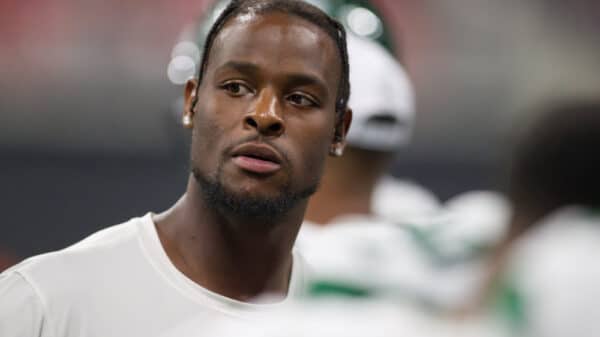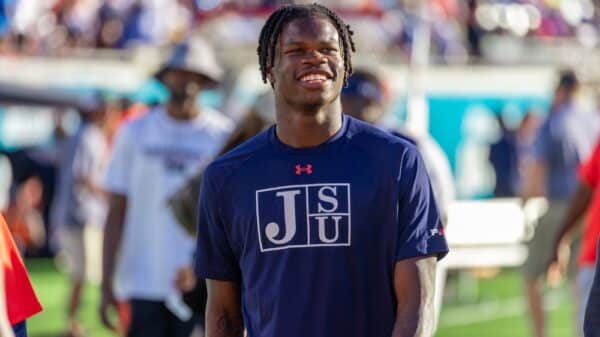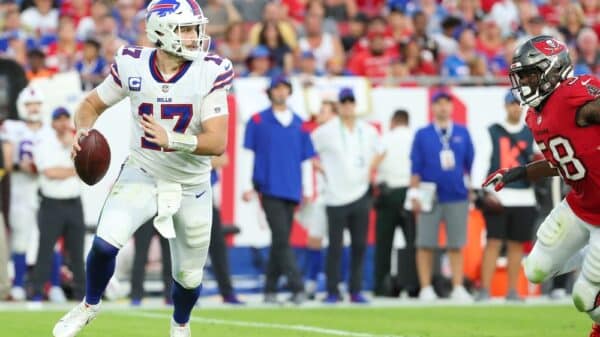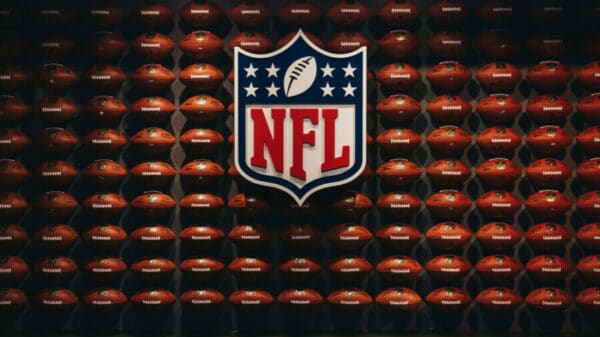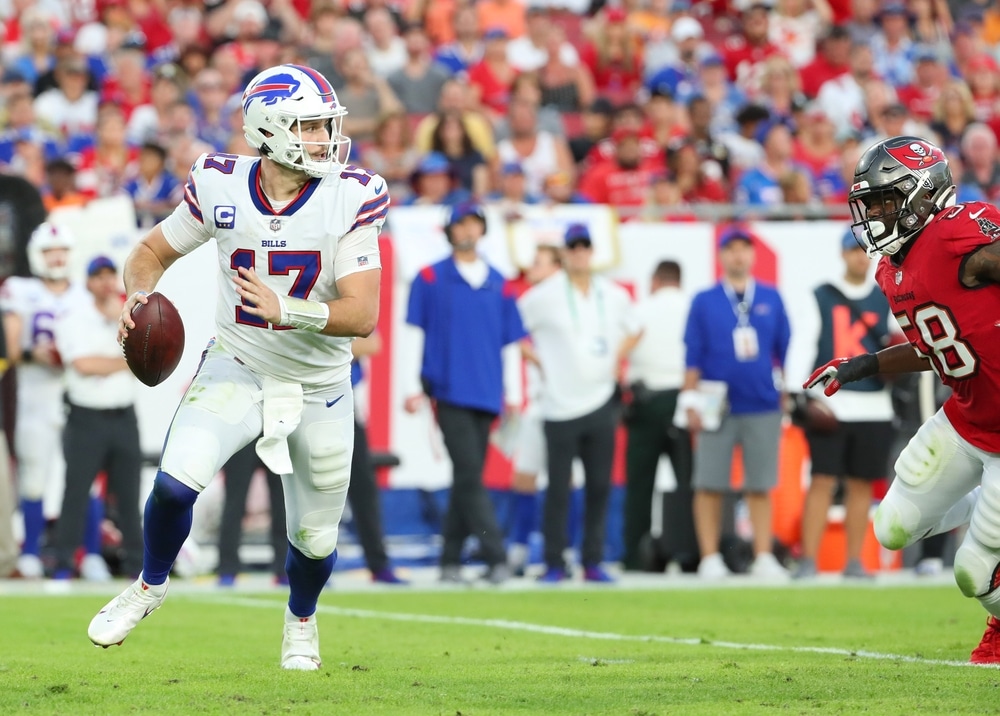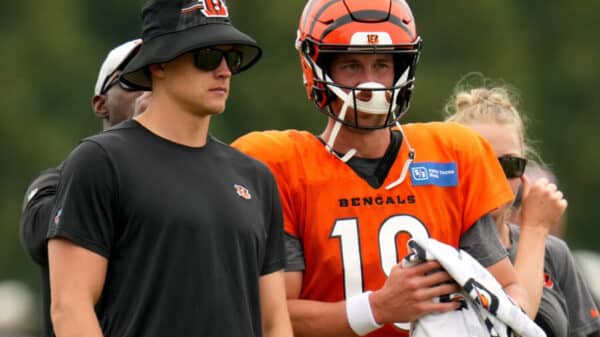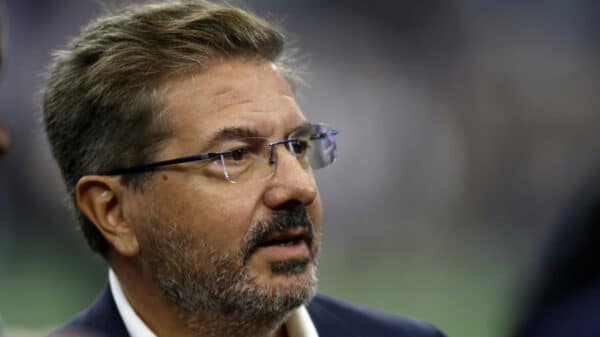Signing Josh Allen to a jaw-dropping, record-setting $330 million contract extension sent shockwaves through the NFL, but for the Buffalo Bills, it was a strategic move that opened up new possibilities in free agency. If this feels like a bit of a financial juggling act, you’re not alone; the mechanics of salary cap management can seem upside-down at times. This maneuver is a testament to the evolving playbook of team finances in the modern NFL, where teams are constantly strategizing to maximize benefits in a landscape that’s as competitive off the field as it is on it.
For Allen, the decision was clear. “I understood the impact of getting an extension done,” he shared with reporters. “This opens up some space for cap and signing some free agents.” His understanding of the financial dance wasn’t just informed speculation; Allen has seen firsthand how vital flexibility in salary cap management is, and he’s fully on board with plans that not only ensure his legacy but also bolster the team’s roster.
Sure enough, the Bills wasted no time after that cap-clearing move. They coughed up $36 million over three years to bring in wide receiver Joshua Palmer, fortified the defensive line with a hefty commitment of over $25 million for talents like Joey Bosa, Michael Hoecht, and Larry Ogunjobi, and even snagged another playmaker in WR Laviska Shenault Jr. As any devoted Bills fan knows, surrounding their franchise quarterback with elite talent is critical for championship ambitions.
To fully grasp the reasoning behind Allen’s extension, it’s essential to take a closer look at the intricate accounting behind NFL salary caps. Each team must balance its books carefully because while base salaries affect the cap immediately, bonuses and certain one-time costs can be prorated over the duration of the contract—sometimes for up to five years. In the big picture, it all nets out the same, but with league revenues skyrocketing annually, a dollar’s value in 2030 will shrink compared to today’s cap realities. For shrewd owners ready to make investments now, this presents a competitive edge. You see, nearly every team has to adhere to a salary cap, but how teams approach cash expenditures can vary wildly, something Amy Trask, a former Oakland Raiders CEO and current CBS analyst, highlighted in a recent interview. “Different team owners have … different levels of willingness as to cash expenditures,” she said, emphasizing the importance of upfront cash flow over constrained cap limitations.
Delving deeper into the numbers, Allen’s six-year deal—which comes with a staggering $250 million in guarantees—reflects this strategy. His base salary for 2025 sits at a modest $1.26 million, but he’s also pocketing a whopping $40 million as a signing bonus. This financial wizardry trims about $3 million off what would have been an exorbitant $44.73 million cap hit for him in that year. The architecture of salary cap management in the NFL is not for the faint of heart; if teams trade tomorrow’s cap space for today’s talent wisely, they can create a powerhouse roster without bending the rules.
Before diving into free agency, the Bills also made a savvy move by extending wide receiver Khalil Shakir’s contract. With a $53 million deal spread across four years, his cap hit this year is just $2.6 million, a figure that will inevitably rise to over $16 million in 2029—unless adjustments are made, but that’s a risk that many teams are willing to gamble on in a quest for a championship trophy.
However, with these creative accounting techniques comes a downside. If a player is no longer on the roster when the bill for those deferred cap hits comes due, it can lead to an accelerated financial reckoning that lands hard in the current season. Yet, for teams with championship aspirations, the potential reward can outweigh the eventual costs, especially when a Lombardi Trophy is part of the equation.
Take the Tampa Bay Buccaneers and the Los Angeles Rams, for instance. Both leveraged significant investments to clinch titles in 2021 and 2022, but they’ve faced the repercussions of inflated cap numbers now that some star players have retired. More recently, the Philadelphia Eagles are taking it a step further, mastering the art of managing cap space while still snagging star players.
The website Over the Cap offers insights into the financial faces of NFL teams, showing that many, on average, could slice their cap numbers by a whopping $46.2 million this year through contract restructures. In stark contrast, Philadelphia has strategically used its space; the Eagles had just $4.2 million unspent, a testament to their aggressive approach in the pursuit of victory.
Jalen Hurts is also part of this grand financial play; his base salary won’t climb above $1.4 million on his $51 million-per-year contract, granting the Eagles much-needed flexibility—flexibility that has allowed the team to nab game-changers like Saquon Barkley on their way to a Super Bowl victory. Spending becomes an art form, and Philadelphia exemplified that by being third overall in cash spending in 2024, sinking $328,561,211 into talent—30% more than what the salary cap dictated.
The Kansas City Chiefs, too, are engaging in this strategic build-up; recent changes to contracts, particularly Patrick Mahomes’ and Chris Jones’, have freed up a staggering $50 million in cap space this year. This sort of financial strategy requires deftness, but for those willing to embrace the risk, the potential rewards can be game-changing.
Reflecting on the modern state of the NFL, Trask noted that while high-revenue teams historically had a leg up, the overall growth of the league has leveled the playing field. “Cash may well now be less of an issue for some clubs,” she stated, suggesting that the possibilities are expanding for all teams as the NFL landscape shifts.
As it stands today, some teams are even turning to private equity for financial relief. Trask observed that “I absolutely think there are some owners who are seeking those investments, such that they have greater latitude in terms of cash expenditures.” This evolving strategy offers teams more options as they navigate the new financial terrains of the league.
The Buffalo Bills had once been at the mercy of their finances, trapped in a cycle of spending limitations in previous ownership eras. However, under the leadership of Terry and Kim Pegula—who bought the franchise for $1.4 billion in 2014—the team has now moved into the top tier of cash spending over recent years. As of now, Spotrac ranks them as second in cash commitments for 2025, a position indicative of their shift toward a more aggressive financial philosophy.
It’s worth noting that the Pegulas sold roughly 20% of the franchise to limited partners last year, including the private equity firm Arctos, cashing in over $1 billion. The Bills are also in the middle of constructing a $2.2 billion stadium, with $850 million coming from public funds—a project that promises to boost their annual revenues significantly once completed.
This week, as the Bills eye more high-value acquisitions, GM Brandon Beane addressed their willingness to follow in the footsteps of franchises like the Eagles, who have become known for spending strategically at critical positions. “Some of it is organizational,” Beane remarked. “Like, ‘Are you willing to spend [above the salary cap]?’ and that starts with Terry Pegula. He gives us the resources to truly go out and be aggressive at certain times.”
The truth is, when teams embrace a “pay now, win later” approach, they’re banking on continuing prosperity in a rapidly evolving NFL environment. Just since 2022, the salary cap has surged by roughly 35%. Projections indicate this upward trajectory will persist, especially with new media deals surfacing in 2030. That means teams are essentially borrowing salary cap space without the burden of interest, compelling them to push for greatness now while the window is still open.
As Allen reportedly texted Bosa before his signing, “If we do what we set out to do, we could be immortalized in this town.” Once that happens, no one will be counting pennies—except for the diligent front office staff who will be managing the impact of the financial strategies long after the celebrations are over. In an intense league where talent is king, the blend of strategic spending and roster-building is the game plan that can ultimately lead to glory.
Image Source: Steve Jacobson / Shutterstock









